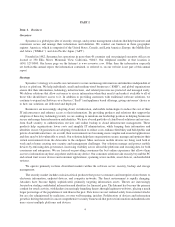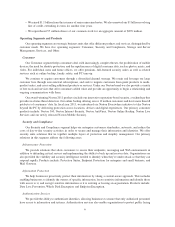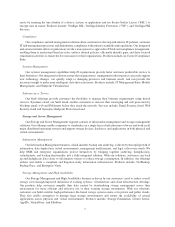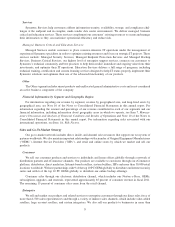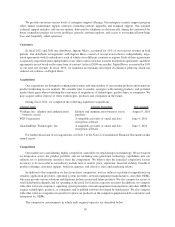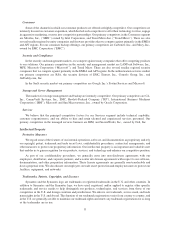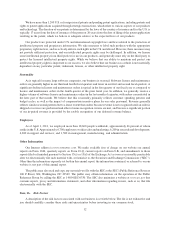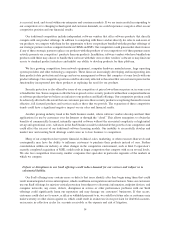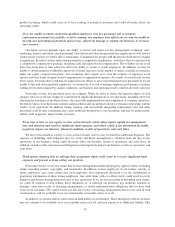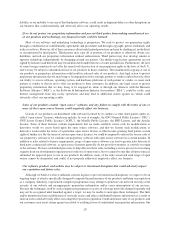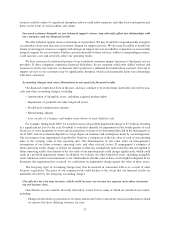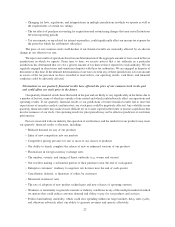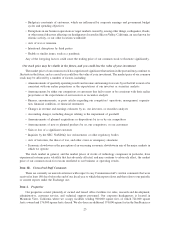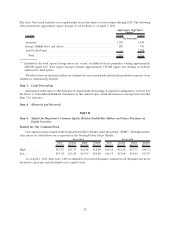Symantec 2011 Annual Report Download - page 84
Download and view the complete annual report
Please find page 84 of the 2011 Symantec annual report below. You can navigate through the pages in the report by either clicking on the pages listed below, or by using the keyword search tool below to find specific information within the annual report.is accessed, used, and stored within our enterprise and consumer markets. If we are unsuccessful in responding to
our competitors or to changing technological and customer demands, we could experience a negative effect on our
competitive position and our financial results.
Our traditional competitors include independent software vendors that offer software products that directly
compete with our product offerings. In addition to competing with these vendors directly for sales to end-users of
our products, we compete with them for the opportunity to have our products bundled with the product offerings of
our strategic partners such as computer hardware OEMs and ISPs. Our competitors could gain market share from us
if any of these strategic partners replace our products with the products of our competitors or if these partners more
actively promote our competitors’ products than our products. In addition, software vendors who have bundled our
products with theirs may choose to bundle their software with their own or other vendors’ software or may limit our
access to standard product interfaces and inhibit our ability to develop products for their platform.
We face growing competition from network equipment, computer hardware manufacturers, large operating
system providers and other technology companies. These firms are increasingly developing and incorporating into
their products data protection and storage and server management software that competes at some levels with our
product offerings. Our competitive position could be adversely affected to the extent that our customers perceive the
functionality incorporated into these products as replacing the need for our products.
Security protection is also offered by some of our competitors at prices lower than our prices or, in some cases
is bundled for free. Some companies offer the lower-priced or free security products within their computer hardware
or software products that we believe are inferior to our products and SaaS offerings. Our competitive position could
be adversely affected to the extent that our customers perceive these security products as replacing the need for more
effective, full featured products and services such as those that we provide. The expansion of these competitive
trends could have a significant negative impact on our sales and financial results.
Another growing industry trend is the SaaS business model, where software vendors develop and host their
applications for use by customers over the Internet or through the “cloud.” This allows enterprises to obtain the
benefits of commercially licensed, internally operated software without the associated complexity or high initial
set-up and operational costs. Advances in the SaaS business model could enable the growth of our competitors and
could affect the success of our traditional software licensing models. Our inability to successfully develop and
market new and existing SaaS offerings could cause us to lose business to competitors.
Many of our competitors have greater financial, technical, sales, marketing, or other resources than we do and
consequently may have the ability to influence customers to purchase their products instead of ours. Further
consolidation within our industry or other changes in the competitive environment, such as Intel Corporation’s
recently completed acquisition of MFE, could result in larger competitors that compete with us on several levels.
We also face competition from many smaller companies that specialize in particular segments of the markets in
which we compete.
Defects or disruptions in our SaaS offerings could reduce demand for our services and subject us to
substantial liability.
Our SaaS offerings may contain errors or defects that users identify after they begin using them that could
result in unanticipated service interruptions, which could harm our reputation and our business. Since our customers
use our SaaS offerings for mission-critical protection from threats to electronic information, endpoint devices, and
computer networks, any errors, defects, disruptions in service or other performance problems with our SaaS
offerings could significantly harm our reputation and may damage our customers’ businesses. If that occurs,
customers could elect not to renew, or delay or withhold payment to us, we could lose future sales or customers may
make warranty or other claims against us, which could result in an increase in our provision for doubtful accounts,
an increase in collection cycles for accounts receivable or the expense and risk of litigation.
14


